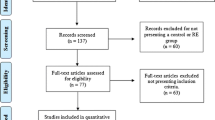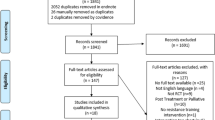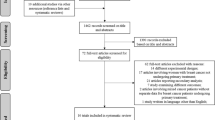Abstract
Background
Changes in body composition during cancer treatments have been linked with poorer outcomes, and increased morbidity and mortality. The effect of resistance training (RT) on body composition in cancer cohorts is debated.
Objective
We conducted a systematic review and meta-analysis to determine the effect of RT on body composition during and after treatment.
Methods
We searched five electronic databases for articles up to 1 February 2021 and included randomized controlled trials that compared RT with a non-exercise control in adults with cancer. Risk of bias was assessed using the RoB 2 tool. Pairwise, random-effects meta-analysis was used to synthesize the available data.
Results
Overall, we included 15 studies (n = 1368). After treatment (11 studies), RT increased lean mass with moderate heterogeneity {0.41 kg [95% confidence interval (CI) 0.05, 0.76], p = 0.029; I2 = 47.1%, p = 0.02} and decreased fat mass with substantial heterogeneity (− 0.59 kg [95% CI − 1.05, − 0.12], p = 0.019; I2 = 69.1%, p < 0.001). During treatment (4 studies), RT did not increase lean mass (0.71 kg [95% CI − 0.04, 1.45], p = 0.05; I2 = 0.0%, p = 0.75) or reduce fat mass (0.00 kg [95% CI − 5.31, 5.30], p = 0.99; I2 = 0.0%, p = 0.62), both with no heterogeneity.
Conclusion
Modest improvements in body composition were observed following RT after cancer treatment; however, no changes were observed during treatment. These adaptations are markedly lower than those observed in healthy cohorts but may be clinically meaningful for the cancer survivorship population. At present it is unclear if these diminished adaptations are due to ineffective exercise prescriptions in cancer cohorts or due to an innate anabolic resistance as a result of cancer and its treatments.
Study registration
Open Science Framework (osf.io/x6z72).




Similar content being viewed by others
Abbreviations
- BMI:
-
Body mass index
- RT:
-
Resistance training
- RM:
-
Repetition maximum
- DXA:
-
Dual-energy X-ray absorptiometry
- MRI:
-
Magnetic resonance imaging
- CT:
-
Computerized tomography
References
Aoyama T. Perioperative body composition changes in the multimodal treatment of gastrointestinal cancer. Surg Today. 2020;50(3):217–22. https://doi.org/10.1007/s00595-019-01815-8.
Demark-Wahnefried W, Peterson BL, Winer EP, et al. Changes in weight, body composition, and factors influencing energy balance among premenopausal breast cancer patients receiving adjuvant chemotherapy. J Clin Oncol. 2001;19(9):2381–9. https://doi.org/10.1200/jco.2001.19.9.2381.
Miyata H, Sugimura K, Motoori M, et al. Clinical assessment of sarcopenia and changes in body composition during neoadjuvant chemotherapy for esophageal cancer. Anticancer Res. 2017;37(6):3053–9. https://doi.org/10.21873/anticanres.11660.
Fattouh M, Chang GY, Ow TJ, et al. Association between pretreatment obesity, sarcopenia, and survival in patients with head and neck cancer. Head Neck. 2019;41(3):707–14. https://doi.org/10.1002/hed.25420.
Chung E, Lee HS, Cho ES, et al. Changes in body composition during adjuvant FOLFOX chemotherapy and overall survival in non-metastatic colon cancer. Cancers (Basel). 2019;12(1):60. https://doi.org/10.3390/cancers12010060.
Kurk SA, Peeters PHM, Dorresteijn B, et al. Loss of skeletal muscle index and survival in patients with metastatic colorectal cancer: Secondary analysis of the phase 3 CAIRO3 trial. Cancer Med. 2020;9(3):1033–43. https://doi.org/10.1002/cam4.2787.
Westcott WL. Resistance training is medicine: effects of strength training on health. Curr Sports Med Rep. 2012;11(4):209–16. https://doi.org/10.1249/JSR.0b013e31825dabb8.
McLeod JC, Stokes T, Phillips SM. Resistance exercise training as a primary countermeasure to age-related chronic disease. Front Physiol. 2019;10:645. https://doi.org/10.3389/fphys.2019.00645.
Irwin ML, McTiernan A, Baumgartner RN, et al. Changes in body fat and weight after a breast cancer diagnosis: influence of demographic, prognostic, and lifestyle factors. Am J Clin Oncol. 2005;23(4):774–82. https://doi.org/10.1200/JCO.2005.04.036.
Carmichael A. Obesity as a risk factor for development and poor prognosis of breast cancer. BJOG. 2006;113(10):1160–6. https://doi.org/10.1111/j.1471-0528.2006.01021.x.
Hayes SC, Newton RU, Spence RR, et al. The Exercise and Sports Science Australia position statement: exercise medicine in cancer management. J Sci Med Sport. 2019;22(11):1175–99. https://doi.org/10.1016/j.jsams.2019.05.003.
Figueiredo VC, de Salles BF, Trajano GS. Volume for muscle hypertrophy and health outcomes: the most effective variable in resistance training. Sports Med. 2018;48(3):499–505. https://doi.org/10.1007/s40279-017-0793-0.
Keilani M, Hasenoehrl T, Baumann L, et al. Effects of resistance exercise in prostate cancer patients: a meta-analysis. Support Care Cancer. 2017;25(9):2953–68. https://doi.org/10.1007/s00520-017-3771-z.
Wanchai A, Armer JM. Effects of weight-lifting or resistance exercise on breast cancer-related lymphedema: a systematic review. Int J Nurs Sci. 2019;6(1):92–8. https://doi.org/10.1016/j.ijnss.2018.12.006.
Fuller JT, Hartland MC, Maloney LT, et al. Therapeutic effects of aerobic and resistance exercises for cancer survivors: a systematic review of meta-analyses of clinical trials. Br J Sports Med. 2018;52(20):1311. https://doi.org/10.1136/bjsports-2017-098285.
Dos Santos WDN, Gentil P, de Moraes RF, et al. Chronic effects of resistance training in breast cancer survivors. Biomed Res Int. 2017;2017:8367803. https://doi.org/10.1155/2017/8367803.
Brown JC, Cespedes Feliciano EM, Caan BJ. The evolution of body composition in oncology-epidemiology, clinical trials, and the future of patient care: facts and numbers. J Cachexia Sarcopenia Muscle. 2018;9(7):1200–8. https://doi.org/10.1002/jcsm.12379.
Strasser B, Steindorf K, Wiskemann J, et al. Impact of resistance training in cancer survivors: a meta-analysis. Med Sci Sports Exerc. 2013;45(11):2080–90. https://doi.org/10.1249/MSS.0b013e31829a3b63.
Moher D, Liberati A, Tetzlaff J, et al. Preferred reporting items for systematic reviews and meta-analyses: the PRISMA statement. BMJ. 2009;339: b2535. https://doi.org/10.1136/bmj.b2535.
Borga M, West J, Bell JD, et al. Advanced body composition assessment: from body mass index to body composition profiling. J Investig Med. 2018;66(5):1–9. https://doi.org/10.1136/jim-2018-000722.
Yang ZR, Sun F, Zhan SY. Risk on bias assessment: (2) Revised Cochrane risk of bias tool for individually randomized, parallel group trials (RoB2.0). Zhonghua Liu Xing Bing Xue Za Zhi. 2017;38(9):1285–91. https://doi.org/10.3760/cma.j.issn.0254-6450.2017.09.028.
Guyatt GH, Oxman AD, Vist GE, et al. GRADE: an emerging consensus on rating quality of evidence and strength of recommendations. BMJ. 2008;336(7650):924–6. https://doi.org/10.1136/bmj.39489.470347.AD.
Viechtbauer W. Conducting meta-analyses in R with the metafor package. J Stat Softw. 2010;36(3):1–48.
IntHout J, Ioannidis JPA, Borm GF. The Hartung-Knapp-Sidik-Jonkman method for random effects meta-analysis is straightforward and considerably outperforms the standard DerSimonian-Laird method. BMC Med Res Methodol. 2014;14(1):25. https://doi.org/10.1186/1471-2288-14-25.
Christensen JF, Jones LW, Tolver A, et al. Safety and efficacy of resistance training in germ cell cancer patients undergoing chemotherapy: a randomized controlled trial. Br J Cancer. 2014;111(1):8–16. https://doi.org/10.1038/bjc.2014.273.
Courneya KS, Segal RJ, Mackey JR, et al. Effects of aerobic and resistance exercise in breast cancer patients receiving adjuvant chemotherapy: a multicenter randomized controlled trial. J Clin Oncol. 2007;25(28):4396–404. https://doi.org/10.1200/JCO.2006.08.2024.
Newton RU, Galvão DA, Spry N, et al. Exercise mode specificity for preserving spine and hip bone mineral density in prostate cancer patients. Med Sci Sports Exerc. 2019;51(4):607–14. https://doi.org/10.1249/MSS.0000000000001831.
Nilsen TS, Raastad T, Skovlund E, et al. Effects of strength training on body composition, physical functioning, and quality of life in prostate cancer patients during androgen deprivation therapy. Acta Oncol. 2015;54(10):1805–13. https://doi.org/10.3109/0284186X.2015.1037008.
Dos Santos WDN, Vieira A, de Lira CAB, et al. Once a week resistance training improves muscular strength in breast cancer survivors: a randomized controlled trial. Integr Cancer Ther. 2019;18:1534735419879748. https://doi.org/10.1177/1534735419879748.
Schmitz KH, Ahmed RL, Hannan PJ, et al. Safety and efficacy of weight training in recent breast cancer survivors to alter body composition, insulin, and insulin-like growth factor axis proteins. Cancer Epidemiol Biomark Prev. 2005;14(7):1672–80. https://doi.org/10.1158/1055-9965.EPI-04-0736.
Schmitz KH, Ahmed RL, Troxel A, et al. Weight lifting in women with breast-cancer-related lymphedema. N Engl J Med. 2009;361(7):664–73. https://doi.org/10.1056/NEJMoa0810118.
Schmitz KH, Ahmed RL, Troxel AB, et al. Weight lifting for women at risk for breast cancer-related lymphedema: a randomized trial. JAMA. 2010;304(24):2699–705. https://doi.org/10.1001/jama.2010.1837.
Segal RJ, Reid RD, Courneya KS, et al. Randomized controlled trial of resistance or aerobic exercise in men receiving radiation therapy for prostate cancer. J Clin Oncol. 2009;27(3):344–51. https://doi.org/10.1200/JCO.2007.15.4963.
Winters-Stone KM, Dieckmann N, Maddalozzo GF, et al. Resistance exercise reduces body fat and insulin during androgen-deprivation therapy for prostate cancer. Oncol Nurs Forum. 2015;42(4):348–56. https://doi.org/10.1188/15.ONF.348-356.
Winters-Stone KM, Dobek J, Nail L, Bennett JA, et al. Strength training stops bone loss and builds muscle in postmenopausal breast cancer survivors: a randomized, controlled trial. Breast Cancer Res Treat. 2011;127(2):447–56. https://doi.org/10.1007/s10549-011-1444-z.
Winters-Stone KM, Dobek J, Nail LM, et al. Impact + resistance training improves bone health and body composition in prematurely menopausal breast cancer survivors: a randomized controlled trial. Osteoporos Int. 2013;24(5):1637–46. https://doi.org/10.1007/s00198-012-2143-2.
Winters-Stone KM, Lyons KS, Dobek J, et al. Benefits of partnered strength training for prostate cancer survivors and spouses: results from a randomized controlled trial of the Exercising Together project. J Cancer Surviv. 2016;10(4):633–44. https://doi.org/10.1007/s11764-015-0509-0.
Kamel FH, Basha MA, Alsharidah AS, et al. Resistance training impact on mobility, muscle strength and lean mass in pancreatic cancer cachexia: a randomized controlled trial. Clin Rehabil. 2020;34(11):1391–9. https://doi.org/10.1177/0269215520941912.
Lam T, Cheema B, Hayden A, et al. Androgen deprivation in prostate cancer: benefits of home-based resistance training. Sports Med Open. 2020;6(1):59. https://doi.org/10.1186/s40798-020-00288-1.
Freedman RJ, Aziz N, Albanes D, et al. Weight and body composition changes during and after adjuvant chemotherapy in women with breast cancer. J Clin Endocrinol. 2004;89(5):2248–53. https://doi.org/10.1210/jc.2003-031874.
Haseen F, Murray LJ, Cardwell CR, et al. The effect of androgen deprivation therapy on body composition in men with prostate cancer: Systematic review and meta-analysis. J Cancer Surviv. 2010;4(2):128–39. https://doi.org/10.1007/s11764-009-0114-1.
Aversa Z, Costelli P, Muscaritoli M. Cancer-induced muscle wasting: latest findings in prevention and treatment. Ther Adv Med Oncol. 2017;9(5):369–82. https://doi.org/10.1177/1758834017698643.
Villaseñor A, Ballard-Barbash R, Baumgartner K, et al. Prevalence and prognostic effect of sarcopenia in breast cancer survivors: the HEAL study. J Cancer Surviv. 2012;6(4):398–406. https://doi.org/10.1007/s11764-012-0234-x.
Sakuma K, Aoi W, Yamaguchi A. Molecular mechanism of sarcopenia and cachexia: recent research advances. Pflugers Arch. 2017;469(5–6):573–91. https://doi.org/10.1007/s00424-016-1933-3.
Fielding RA, Vellas B, Evans WJ, et al. Sarcopenia: an undiagnosed condition in older adults. Current consensus definition: prevalence, etiology, and consequences. International Working Group on Sarcopenia. J Am Med Dir Assoc. 2011;12(4):249–56. https://doi.org/10.1016/j.jamda.2011.01.003.
von Haehling S, Anker SD. Cachexia as a major underestimated and unmet medical need: facts and numbers. J Cachexia Sarcopenia Muscle. 2010;1(1):1–5.
Cole CL, Kleckner IR, Jatoi A, et al. The role of systemic inflammation in cancer-associated muscle wasting and rationale for exercise as a therapeutic intervention. JCSM Clin Rep. 2018;3(2):e00065.
Christensen JF, Jones LW, Andersen JL, et al. Muscle dysfunction in cancer patients. Ann Oncol. 2014;25(5):947–58. https://doi.org/10.1093/annonc/mdt551.
Harimoto N, Shirabe K, Yamashita YI, et al. Sarcopenia as a predictor of prognosis in patients following hepatectomy for hepatocellular carcinoma. Br J Surg. 2013;100(11):1523–30. https://doi.org/10.1002/bjs.9258.
Coelen RJ, van Gulik TM. Preoperative sarcopenia negatively impacts postoperative outcomes following major hepatectomy with extrahepatic bile duct resection. World J Surg. 2015;39(9):2368–9. https://doi.org/10.1007/s00268-015-3053-1.
Benito PJ, Cupeiro R, Ramos-Campo DJ, et al. A systematic review with meta-analysis of the effect of resistance training on whole-body muscle growth in healthy adult males. Int J Environ Res Public Health. 2020;17(4):1285.
Hagstrom AD, Marshall PW, Halaki M, et al. The effect of resistance training in women on dynamic strength and muscular hypertrophy: a systematic review with meta-analysis. Sports Med. 2020;50(6):1075–93. https://doi.org/10.1007/s40279-019-01247-x.
Peterson MD, Sen A, Gordon PM. Influence of resistance exercise on lean body mass in aging adults: a meta-analysis. Med Sci Sports Exerc. 2011;43(2):249–58. https://doi.org/10.1249/MSS.0b013e3181eb6265.
Jones MD, Wewege MA, Hackett DA, et al. Sex differences in adaptations in muscle strength and size following resistance training in older adults: a systematic review and meta-analysis. Sports Med. 2021;51(3):503–17. https://doi.org/10.1007/s40279-020-01388-4.
Borde R, Hortobágyi T, Granacher U. Dose-response relationships of resistance training in healthy old adults: a systematic review and meta-analysis. Sports Med. 2015;45(12):1693–720. https://doi.org/10.1007/s40279-015-0385-9.
Meneses-Echavez JF, Rodriguez-Prieto I, Elkins M, et al. Analysis of reporting completeness in exercise cancer trials: a systematic review. BMC Med Res Methodol. 2019;19(1):220. https://doi.org/10.1186/s12874-019-0871-0.
Neil-Sztramko SE, Medysky ME, Campbell KL, et al. Attention to the principles of exercise training in exercise studies on prostate cancer survivors: a systematic review. BMC Cancer. 2019;19(1):321. https://doi.org/10.1186/s12885-019-5520-9.
Neil-Sztramko SE, Winters-Stone KM, Bland KA, et al. Updated systematic review of exercise studies in breast cancer survivors: attention to the principles of exercise training. Br J Sports Med. 2019;53(8):504–12. https://doi.org/10.1136/bjsports-2017-098389.
Andreoli A, Scalzo G, Masala S, et al. Body composition assessment by dual-energy X-ray absorptiometry (DXA). Radiol Med (Torino). 2009;114(2):286–300. https://doi.org/10.1007/s11547-009-0369-7.
Barreira TV, Tseh W. The effects of acute water ingestion on body composition analyses via Dual-Energy X-Ray Absorptiometry. Clin Nutr. 2020;39(12):3836–8. https://doi.org/10.1016/j.clnu.2020.03.037.
Hui D, Dev R, Bruera E. The last days of life: symptom burden and impact on nutrition and hydration in cancer patients. Curr Opin Support Palliat Care. 2015;9(4):346–54. https://doi.org/10.1097/spc.0000000000000171.
Marinangeli CP, Kassis AN. Use of dual X-ray absorptiometry to measure body mass during short- to medium-term trials of nutrition and exercise interventions. Nutr Rev. 2013;71(6):332–42. https://doi.org/10.1111/nure.12025.
Price KA. Hydration in cancer patients. Curr Opin Support Palliat Care. 2010;4(4):276–80. https://doi.org/10.1097/SPC.0b013e32833e48d1.
Tinsley GM, Morales E, Forsse JS, Grandjean PW. Impact of acute dietary manipulations on DXA and BIA body composition estimates. Med Sci Sports Exerc. 2017;49(4):823–32. https://doi.org/10.1249/mss.0000000000001148.
Toomey CM, Cremona A, Hughes K, et al. A review of body composition measurement in the assessment of health. Top Clin Nutr. 2015;30(1):16–32. https://doi.org/10.1097/tin.0000000000000017.
El Maghraoui A, Achemlal L, Bezza A. Monitoring of dual-energy X-ray absorptiometry measurement in clinical practice. J Clin Densitom. 2006;9(3):281–6. https://doi.org/10.1016/j.jocd.2006.03.014.
Hangartner TN, Warner S, Braillon P, et al. The official positions of the international society for clinical densitometry: acquisition of dual-energy X-ray absorptiometry body composition and considerations regarding analysis and repeatability of measures. J Clin Densitom. 2013;16(4):520–36. https://doi.org/10.1016/j.jocd.2013.08.007.
Bazzocchi A, Ponti F, Albisinni U, et al. DXA: technical aspects and application. Eur J Radiol. 2016;85(8):1481–92. https://doi.org/10.1016/j.ejrad.2016.04.004.
Nana A, Slater GJ, Hopkins WG, et al. Importance of standardized DXA protocol for assessing physique changes in athletes. Int J Sport Nutr. 2016;26(3):259–67. https://doi.org/10.1123/ijsnem.2013-0111.
Wells JC, Fewtrell MS. Measuring body composition. Arch Dis Child. 2006;91(7):612–7. https://doi.org/10.1136/adc.2005.085522.
Morton RW, Murphy KT, McKellar SR, et al. A systematic review, meta-analysis and meta-regression of the effect of protein supplementation on resistance training-induced gains in muscle mass and strength in healthy adults. Br J Sports Med. 2018;52(6):376–84. https://doi.org/10.1136/bjsports-2017-097608.
Madzima TA, Ormsbee MJ, Schleicher EA, et al. Effects of resistance training and protein supplementation in breast cancer survivors. Med Sci Sports Exerc. 2017;49(7):1283–92. https://doi.org/10.1249/mss.0000000000001250.
Pamoukdjian F, Bouillet T, Lévy V, et al. Prevalence and predictive value of pre-therapeutic sarcopenia in cancer patients: a systematic review. Clin Nutr. 2018;37(4):1101–13. https://doi.org/10.1016/j.clnu.2017.07.010.
Prado CMM, Baracos VE, McCargar LJ, et al. Sarcopenia as a determinant of chemotherapy toxicity and time to tumor progression in metastatic breast cancer patients receiving capecitabine treatment. J Clin Cancer Res. 2009;15(8):2920–6. https://doi.org/10.1158/1078-0432.CCR-08-2242.
Shachar SS, Deal AM, Weinberg M, et al. Skeletal muscle measures as predictors of toxicity, hospitalization, and survival in patients with metastatic breast cancer receiving taxane-based chemotherapy. J Clinical Cancer Research. 2017;23(3):658–65. https://doi.org/10.1158/1078-0432.CCR-16-0940.
Shachar SS, Deal AM, Weinberg M, et al. Body composition as a predictor of toxicity in patients receiving anthracycline and taxane-based chemotherapy for early-stage breast cancer. J Clin Cancer Res. 2017;23(14):3537–43. https://doi.org/10.1158/1078-0432.CCR-16-2266.
Koeppel M, Mathis K, Schmitz KH, et al. Muscle Hypertrophy in cancer patients and survivors via strength training. A meta-analysis and meta-regression. Crit Rev Oncol. 2021;163: 103371. https://doi.org/10.1016/j.critrevonc.2021.103371.
Vergara-Fernandez O, Trejo-Avila M, Salgado-Nesme N. Sarcopenia in patients with colorectal cancer: a comprehensive review. World J Clin Cases. 2020;8(7):1188–202. https://doi.org/10.12998/wjcc.v8.i7.1188.
Cruz-Jentoft AJ, Sayer AA. Sarcopenia. Lancet. 2019;393(10191):2636–46. https://doi.org/10.1016/S0140-6736(19)31138-9.
Beaudart C, Zaaria M, Pasleau F, et al. Health outcomes of sarcopenia: a systematic review and meta-analysis. PLoS ONE. 2017;12(1): e0169548. https://doi.org/10.1371/journal.pone.0169548.
Author information
Authors and Affiliations
Corresponding author
Ethics declarations
Funding
The authors disclose no funding was received for this project. Michael A. Wewege was supported by a Postgraduate Scholarship from the National Health and Medical Research Council of Australia, a School of Medical Sciences Top-Up Scholarship from the University of New South Wales, and a PhD Supplementary Scholarship from Neuroscience Research Australia. Hayley B. Leake was supported by an Australian Government Research Training Program Scholarship.
Conflicts of interest
Briana Clifford, Sean Koizumi, Michael A. Wewege, Hayley B. Leake, Lauren Ha, Eliza Macdonald, Ciaran M. Fairman and Amanda D. Hagstrom declare they have no conflicts of interest.
Ethics approval
Not applicable.
Consent to participate
Not applicable.
Consent for publication
Not applicable.
Availability of data and material
The data and R script used in the meta-analysis are also available on the Open Science Framework (osf.io/x6z72).
Author contributions
Conceptualization: BC, ADH. Methodology: BC, ADH, MAW. Formal analysis: MAW. Investigation: all authors. Project administration: ADH. Validation: ADH, BC. Supervision: ADH. Visualization: MAW. Writing—original draft: BC, ADH. Writing—review and editing: all authors.
Supplementary Information
Below is the link to the electronic supplementary material.
Rights and permissions
About this article
Cite this article
Clifford, B., Koizumi, S., Wewege, M.A. et al. The Effect of Resistance Training on Body Composition During and After Cancer Treatment: A Systematic Review and Meta-Analysis. Sports Med 51, 2527–2546 (2021). https://doi.org/10.1007/s40279-021-01542-6
Accepted:
Published:
Issue Date:
DOI: https://doi.org/10.1007/s40279-021-01542-6




